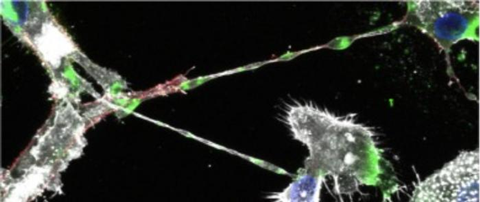Understanding how viruses travel once inside the human body is critical to develop effective drugs and therapies that can stop viruses in their tracks.

Scientists at Texas Biomedical Research Institute (Texas Biomed) recently published findings in the Journal of Infectious Diseases indicating that Ebola virus creates and uses intercellular tunnels to move from cell to cell and evade treatments.
“Our findings suggest that the virus can create its hiding place, hide and then move to new cells and replicate,” says Olena Shtanko, PhD, an Assistant Professor at Texas Biomed and senior paper author.
Tunnelling nanotubes
Specifically, the virus is generating something called tunneling nanotubes – dynamic connections between cells that allow the cells to communicate by exchanging particles over relatively long distances, up to 200 microns. While these structures have been shown to play a prominent role in promoting neurodegenerative diseases, cancer, HIV-1 and influenza, Dr. Shtanko is the first to investigate their role in disseminating Ebola virus.
“When we launched this project a couple of years ago, we thought the general model of spread of Ebola virus infection – where a viral particle infects a cell, replication begins, new virus particles are made and released into the body to infect neighboring cells – was a bit too simplistic,” says Dr. Shtanko.
Using state-of-the-art technology with live scanning electron and high-resolution 3D-microscopy, Dr. Shtanko and her team showed that Ebola virus infection in cells enhanced the formation of tunneling nanotubes containing viral particles. The tunneling nanotubes then promoted the transfer of these particles to other cells. Notably, the full virus was not required to trigger nanotube formation, only small sections of the virus coding for individual proteins were needed.
Evading treatment
This happened even in the presence of treatments meant to stop Ebola virus.
“Importantly, we observed that Ebola virus infection could spread in cultures treated with virus entry inhibitors or therapeutic treatments that stop viruses from entering a cell,” Dr. Shtanko explains.
How exactly Ebola virus particles are transported through tunneling nanotubes is still an open question. Dr. Shtanko and her team plan to try to find answers using advanced technologies such laser microdissection, mass spectrometry and low-abundance RNA sequencing. They will also explore if related viruses, including the deadly Sudan and Marburg viruses, exploit the same mechanism to spread infection. In collaboration with Texas Biomed Professor Ricardo Carrion, Jr., PhD, the team will analyze tissues from animal models for virus-containing nanotubes.







No comments yet